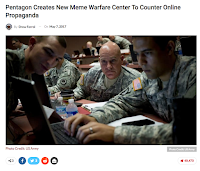 I spent more time than usual in front of my computer today
and as a reward left my more enjoyable and interesting e-mail for the end of
the day. I was struck by the juxtaposition of two articles. The first was from
the May 17, 2017 Task & Purpose, “5 Maps that Show The Military Hotspots
The US Military is Deployed Right Now” (see: http://bit.ly/2raCZjY;
which is also a photo source. As an analyst I tend to look for things that are
unusual.
I spent more time than usual in front of my computer today
and as a reward left my more enjoyable and interesting e-mail for the end of
the day. I was struck by the juxtaposition of two articles. The first was from
the May 17, 2017 Task & Purpose, “5 Maps that Show The Military Hotspots
The US Military is Deployed Right Now” (see: http://bit.ly/2raCZjY;
which is also a photo source. As an analyst I tend to look for things that are
unusual.  Top of the ‘unusual’ list is the deployment of 300 Marines
to Norway. The Army’s list showed a deployment of 3,500 in Poland. These two
deployments are clearly meant to counter a perceived Russian threat and/or to
make a statement about one. Given the headlines of actions in Afghanistan, Iraq
and Syria – these two stood out.
Top of the ‘unusual’ list is the deployment of 300 Marines
to Norway. The Army’s list showed a deployment of 3,500 in Poland. These two
deployments are clearly meant to counter a perceived Russian threat and/or to
make a statement about one. Given the headlines of actions in Afghanistan, Iraq
and Syria – these two stood out.
On the Navy list I was somewhat surprised to see that the
USS Carney Ross is deployed to South Sudan. I thought South Sudan was land
locked which would make it a bit difficult to deploy an Arliegh Burke-class
guided-missile destroyer inland.
As it turns out, this potential anomaly tied into the second
article from Task & Purpose on May 18, 2017 “Report: SOCOM Has More Troops
in Africa Than Anywhere Except the Middle East” (see: http://bit.ly/2qOKJaf; which is also a photo
source.)
One could view the non-SOCOM Deployments as actions that are
in play. Meaning that these conflict areas have enough going-on that it is
necessary to station conventional forces. The Marines and the Navy, generally
viewed as more mobile can be shifted to other locations more quickly.
However, the biggest takeaway is that SOCOM forces are a
‘preview to coming attractions’ and portend where the next major deployments
can be expected to take place. BG Donald Bolduc, head of SOCAFRICA’s thoughts
were summarized as ““Africa’s challenges could create a
threat that surpasses the threat that the United States currently faces from
conflict in Afghanistan, Iraq, and Syria,” Bolduc warned. He went on to cite a
laundry list of challenges with which he and his personnel must contend:
ever-expanding illicit networks, terrorist safe havens, attempts to subvert
government authority, a steady stream of new recruits and resources.”
Reader comments, as always are encouraged and I’m especially
curious as to feedback on the Carney Ross.





